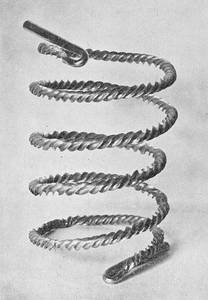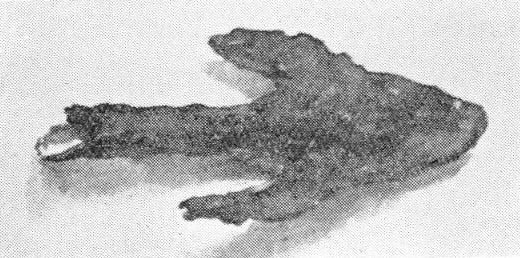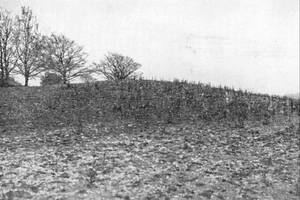The Gold Torque
In 1845 a beautiful gold torque was ploughed up in a field at Lyeway, Ropley, probably on the site of some ancient burial ground. It was of the usual twisted pattern. terminating in recurved hooks of solid metal, and absolutely perfect, bright and uninjured save for one dent caused by the plough.
This beautiful ornament weighed over 5-oz. and was exhibited by Mr. Lilywhite, on whose ground it was found, at a meeting of the Archaeological Institute at Winchester in 1845. For a number of years it was preserved at Lyewood, the residence of Mr. Lilywhite, after which it passed into the collection of Sir John Evans, whose son, Sir Arthur Evans, sold it at Sotheby's in 1925 to the Cornwall County Museum, Truro. It is assigned to the late Bronze Age, about 1,000-800 B.C. and is of a type common in Britain but exceptional abroad. Most of them were worn round the neck, though the Ropley specimen seems to be adapted for the wrist.
The Torque
Two Ancient Relics
Some few years ago an iron arrow-head of mediaeval times, probably of the 14th century, was dug up on the north side of the churchyard, when a grave was being made.
I understand by a letter from the British Museum asking for its position in regard to the body, that if lying parallel with the skeleton and near the shoulder it would probably have been the dead man's favourite weapon, which was buried with him; if in any other position he may have been killed with it.
Arrow Head
It was impossible, however, to obtain any details as to its position, for it was not noticed until dug up.
About the same time, also in the churchyard, a Nuremberg counter of the 17th century was found. These were used with a chequer board for making up accounts. The best known survival of the usage is preserved in the title of the "Exchequer."
These counters were produced in great numbers and many of them were made in Nuremberg. This coin bears the name of its maker - Hans Schu... ?
Coins
The Barrow
A solitary barrow of the bronze age (which came to an end about 500 B.C.) stands here in an open field on the western side of Old Down Wood. I have never been able to discover any authentic record of its having been opened, but like most of the "round" barrows in this neighbourhood it probably contains nothing but burnt bones or possibly some fragile urns. It is a thousand pities that these ancient relics should so many of them be gradually levelled by the plough. The village people's idea used to be that here "some great battle was fought."
The Barrow
The Semaphore
In a green lane on the outskirts of this parish not far from the Alton road stands the old Semaphore - or Telegraph as it is usually called.
This means of communication was first established by the French in 1794. The invention was due to a man named Chappe, who called it a Telegraph - the term Semaphore was of later date. By means of signals made by two vast arms in various positions, intelligence was rapidly given from hill to hill. In this case I think Beacon Hill, near Petersfield, would have been the next station. Such great rapidity was obtained that the hour of noon could be signalled from Greenwich to Portsmouth and an acknowledgement received in one and a half minutes.
The old Telegraph house is now used as an Isolation Hospital in connection with Alton.



